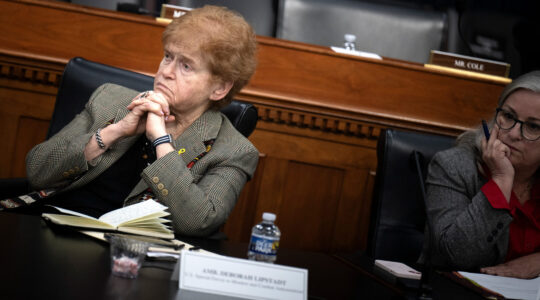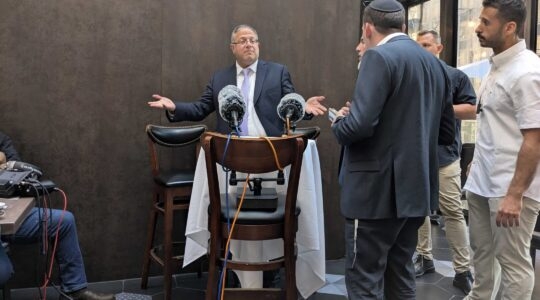NEW YORK (JTA) — “We can’t just blindly throw money at our problems,” Scott Goldberg said at a lunch meeting at Yeshiva University’s mid-Manhattan campus, referring to the economic crisis that is imperiling the country’s Jewish day school system.
“None of us can afford to do that in this economy,” Goldberg, the head of YU’s Institute of University-School Partnership, told education officials and journalists Monday in a meeting to introduce a new survey on the governance of day schools.
For the survey, Yeshiva University reached out to hundreds of board presidents at day schools, asking them to self-evaluate how their boards — their economic lifelines — function. It received received 71 responses — or about a quarter of four major networks of U.S. day schools, the university said — from across the denominational spectrum. According to YU officials, the presients’ responses to several questions suggest that boards need to improve in several key areas in order to ensure the financial viabity of their schools.
The day school system in the United States is a $2 billion a year enterprise that requires $500 million annually in financial aid for students, according to Harry Bloom, the YU official who produced the “Survey of the Governance Practices of Jewish Day Schools.” And, as the economy has tanked, major questions have emerged over whether and how schools can survive.
Among the survey’s finding:
* 38 percent of the board presidents strongly agreed when asked if their boards had set strategic goals for their schools three to five years from now.
* 35 percent strongly agreed that their boards had a financial plan for the next three to five years.
* About half said their boards had established committees to work on their obligations, but only 26 percent of the presidents answered "strongly agree" when asked to rate how the rest of the board followed through on the committees’ recommendations during general board meetings.
* 31 percent said that they have subcommittees whose goal is to identify prospective board members that have valuable financial connections and professional skills they can volunteer to help their schools with specific issues.
* 75 percent said they annually evaluate the performance of their heads of school and 71 percent said they have created board by-laws to limit how many consecutive terms a board member can serve.

Bloom and others say the findings show that boards of directors seemingly are not as dedicated to their task as they could be, and do not fund-raise or plan effectively. Even when they manage to set goals, they often go unmet.
It’s a poisonous mix, Bloom said, that often comes from board members becoming involved and recruiting other members for social reasons and not necessarily out of interest for the institutions they are tasked with helping.
The pattern is found across all sectors of the nonprofit world, he added. Instead of taking time and thought to find qualified and motivated members, board members simply reach out to friends several days before they are required to put in place new members.
Bloom, an expert in lay board management for YU’s Institute for University-School Partnership, floated several ideas for solving the day school tuition crisis, such as a massive communal fund-raising drive to build a huge endowment. Still, he said, even though a $1 billion endowment could help, such a mega fund only would provide $50 million per year in real aid, and that’s not enough.
Along with seeking to create a mega fund, Bloom suggested that day schools must try to collaborate with other schools and local organizations to see if they can save on overhead, as well as share space and office support. That, Bloom said, could save the system $50 million to $150 million.
That, along with an increase in support from the government and day schools seeking to trim approximately $100 million from their operating expenses, could help bridge the $500 million annual gap created by financial need for students.
None of this can happen, however, without the schools having strong boards of directors — which they do not, according to Bloom’s study.
“Boards spend half their time schmoozing,” he told JTA. “If they are spending their time schmoozing, then they are not spending their time on planning.”
Bloom told JTA that schools can take simple steps, such as asking board members to sign contracts with set expectations for philanthropic and volunteer involvement.
He employed the method at the South Area Solomon Schechter School in Massachusetts, where he was in charge of institutional advancement for five years before coming to Yeshiva University this year. The school was able to increase its fund raising eight-fold by doing so, Bloom said.
YU is working with three pilot communities — the Five Towns on Long Island, N.Y., Philadelphia and Bergen County, N.J. — to convene schools, Jewish federations and local Jewish organizations to address the issue. And it is planning to take the survey results on the road, to Jewish communities in Los Angeles and other cities.
For Jewish educators, the day school funding crisis has become a national concern.
The Partnership for Jewish Education just finished developing a three-part strategic plan to help day schools that involves making sure that every school has a competent, inspiring head of school, a strong board and a sustainable financial model.
But while many would like to cap the cost of day school tuitions, even the final sticker price is heavily discounted with the help of philanthropic support.
“Every kid has a discounted tuition — and it still costs $18,000 per year,” Cheryl Finkel, a PEJE consultant, told JTA, noting the average cost per school term for parents, even with aid.
In recent months both YU and the Orthodox Union have become more involved in the funding crisis. The OU has convened several meetings of day school officials and lay leaders to seek stoppers for the gaping financial holes. And YU is spending some $2 million per year on its Institute for University-School Partnership.
The reasoning is simple, says YU President Richard Joel.
“We are the largest developer of teachers and educators for these communities," Joel told JTA in a telephone interview. "We have 40 doctoral students and 12 master’s degree students per year. We want to make sure there are quality places for them to teach.”
YU for the first time has hired a job placement director for teachers, but Joel is also looking out for his undergraduate program.
“If we don’t help strengthen the yeshiva school system," he said, "where am I going to get my students?”
CORRECTION: An earlier version of this story inaccurately implied that the YU report offered strong, direct criticism of the boards of directors of Jewish day schools. The earlier version of the article also contained incorrect information about the number of schools that responded to the survey.
JTA has documented Jewish history in real-time for over a century. Keep our journalism strong by joining us in supporting independent, award-winning reporting.





